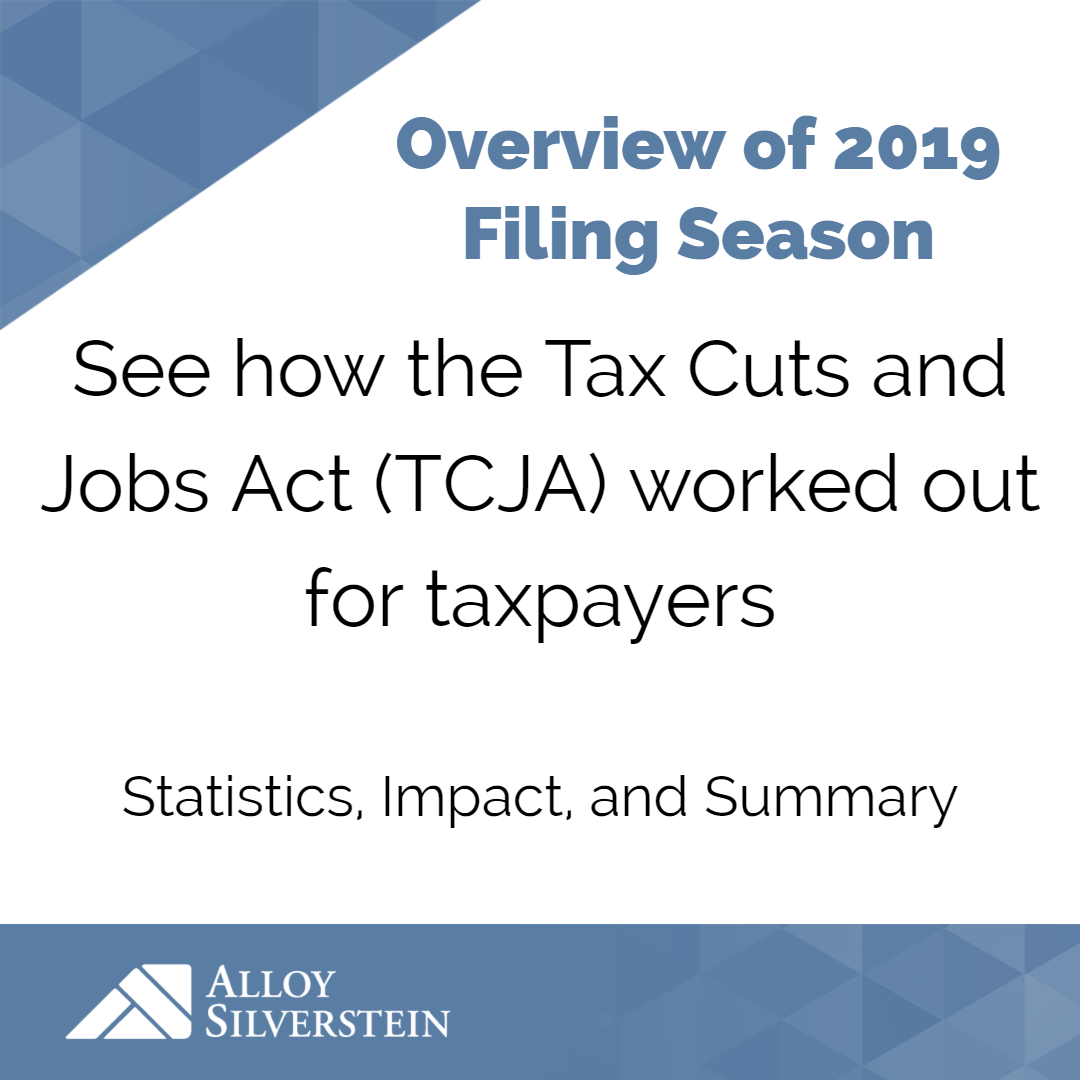

The Tax Cuts and Jobs Act (TCJA) passed by Congress was the most sweeping overhaul to the United States tax code in over 30 years. Although many politicians promised “simplification,” most tax professionals would certainly disagree. While TCJA did indeed simplify things in certain respects, the introduction of §199A deduction commonly referred to as the Qualified Business Income Deduction (QBID) brought about all different types of complex calculations that were new for everyone involved. The doubling of the standard deduction substantially reduced the number of filers who would benefit from itemizing their deductions, which in turn makes their returns simpler. Since tax season has finally concluded, we can begin to dive into the data and see how the TCJA shakes out for taxpayers.
The Internal Revenue Service produces filing season statistics every year on a weekly basis as filing season progresses. There are some interesting findings in the data reported as of 4/19/2019. The IRS received 126,264,000 electronically filed returns in the 2019 filing season; an increase of roughly 1.7 million returns compared to 2018 filing season. Of the electronically filed returns, an additional 2.25 million people marked their returns as “self-prepared.” It’s difficult to tell whether this correlates to the increase in returns processed, or whether this group of taxpayers felt the new law simplified their returns enough where they no longer the needed help of accountants and tax professionals. According to the IRS, electronically filed returns prepared by tax professionals slightly decreased by around 500,000. Again, it’s difficult to pinpoint the specific reason. Generally, taxpayers who use a professional to prepare their returns already have more complex tax situations where professional advice is necessary.
 We were able to conduct our own analysis of tax returns that Alloy Silverstein prepared as a firm during the 2019 filing season. For our analysis we chose a sample of 632 individual tax returns. Of the 632, only 97 of these returns saw their effective tax rate increase. Additionally, only 17 of these 97 saw their effective tax rates increase by more than 5%. The returns with an effective tax rate increase greater than 5% showed material changes in taxable income. Effective tax rate is calculated by dividing actual tax liability by taxable income. Since the tax code represents a progressive tax rate scheme, the marginal tax “bracket” you filter into is not indicative of the actual rate of tax you pay on all of your income. Effective tax rate provides a better metric to assess how our clients fared under the new laws. Taxable income and tax liability are the other metrics we used in our analysis and provided for some interesting results.
We were able to conduct our own analysis of tax returns that Alloy Silverstein prepared as a firm during the 2019 filing season. For our analysis we chose a sample of 632 individual tax returns. Of the 632, only 97 of these returns saw their effective tax rate increase. Additionally, only 17 of these 97 saw their effective tax rates increase by more than 5%. The returns with an effective tax rate increase greater than 5% showed material changes in taxable income. Effective tax rate is calculated by dividing actual tax liability by taxable income. Since the tax code represents a progressive tax rate scheme, the marginal tax “bracket” you filter into is not indicative of the actual rate of tax you pay on all of your income. Effective tax rate provides a better metric to assess how our clients fared under the new laws. Taxable income and tax liability are the other metrics we used in our analysis and provided for some interesting results.


Based on our sample, some income levels certainly reaped the benefits more than others. Filers with 2018 taxable income between $200,000 and $600,000 saw their effective tax rate decrease between 4.6% and 6.8% on average. Other income levels received more modest benefits from the new tax laws. In our sample, filers with 2018 taxable income less than $200,000 paid a lower effective rate between 2.1% and 3.3% on average.
All in all, the majority of taxpayers received at least some benefit from TCJA. Our analysis focused solely on tax liability and its relationship to taxable income levels over a two year period. Determining whether taxpayers on average saw bigger refunds is a whole other story. Someone can actually pay less income tax and receive a smaller refund check from the government. The amount of one’s refund (or balance due) is a function of their taxable income and amount of taxes already paid to the government whether via paycheck withholding or by making estimated tax payments. It’s important for W-2 employees to keep an eye on their pay stubs to ensure an adequate amount is being withheld for federal and state income taxes each period. Ensuring that your withholding is sufficient can go a long way to prevent a surprise tax bill come next spring.
If your tax bill was higher than expected or your refund lower than desired, it’s time to setup a tax planning meeting to prepare for 2020. Contact an Alloy Silverstein CPA today.
Author: Matthew Rosenthal
Empowering business owners and individuals in South Jersey and Philadelphia to feel confident through proactive accounting and advisory solutions.